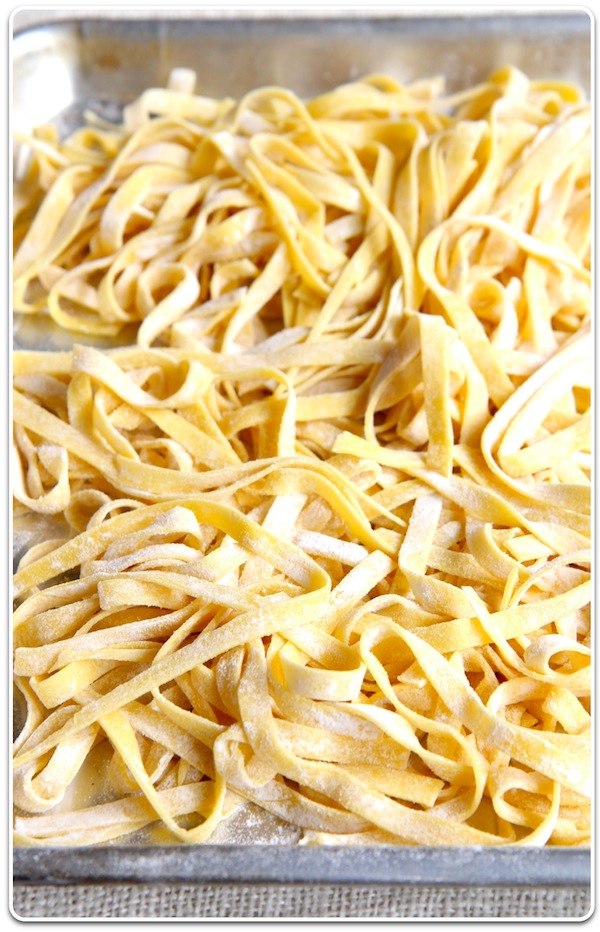
I'm going to be showing you lots of fresh pasta recipes this next year and I hope you will cook right along with me. Fresh homemade pasta is truly a fun thing to make and has so many creative possibilities. And you can make it at a moment's notice - who doesn't have eggs and flour in their kitchen? I've posted about making fresh pasta before, but I wanted to do an update and include a video to show you just how easy it is. I know when people can see something being made they are more likely to try it. So the video within this post may inspire you to make the leap!
There is no one correct recipe for fresh pasta. In Italy, different regions have different ways of making it. Some places only use eggs and flour and others use only water and flour. Some cooks add a little salt and olive oil, some do not. You will have to experiment and decide what pasta recipe you like. How do I like to make mine? I basically make my pasta the way they do in the Emilia Romagna region of Italy - with just fresh eggs and flour.
for a printable version of the pasta recipe, click here
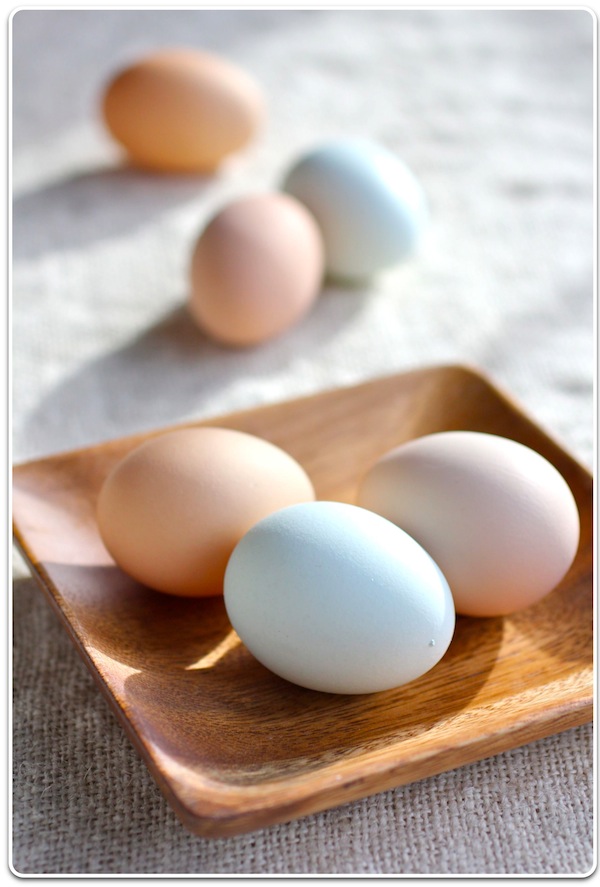
Although you can certainly use the eggs you buy in the grocery store and good old plain All Purpose flour, if you want to take your pasta to the next level, you can use superior ingredients - after all, if there are only two ingredients in fresh pasta, why not make them the best? If you can, buy fresh farm eggs. The yolks are richer and darker in color - your pasta will be better tasting and golden. Try to let your eggs come to room temperature because it will make the dough easier to work. For the flour, Italian 00 flour is a special treat, as it makes a very delicate pasta. Italian 00 flour is very finely milled flour, high in protein and soft as a baby's bottom. I love fettuccine, especially, made from this flour.
Another way I make fresh pasta sometimes is to use half regular flour and half durum semolina flour. When I make pastas that I want to have a little more "tooth" to them, as when I make ravioli, I will sometimes make this pasta. The semolina flour is harder than regular flour. It takes a little more kneading but is worth the effort. If you use some semolina flour in your pasta dough, you will have to add either more eggs to the dough or, as I do, just add a little water in to make the dough more workable. These are all things that you can experiment with and see what you like - pasta dough is hard to mess up.
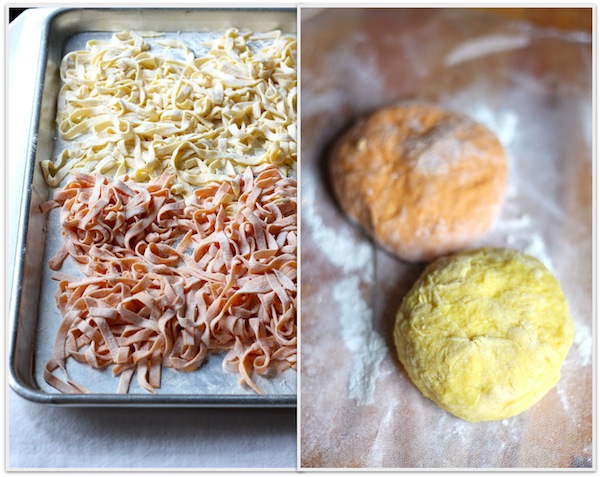
fresh tomato and plain fettuccine
Making flavored pastas is easy, too. The tomato pasta above just has a little bit of tomato paste added to the dough. That's it. The video in this post shows how to make spinach pasta by just steaming a little bit of fresh spinach and making the dough with that. For spinach pasta, it's better to make the dough in a food processor because it blends the spinach a little better than by hand (although you can certainly do it by hand - just chop the spinach very finely before adding it to the dough). There are all kinds of flavors you can add to pasta once you master the basic plain pasta - peppered pasta, beet pasta, saffron pasta, herb pasta, and on and on. If you make flavored pastas that use moist or wet ingredients like tomato paste or spinach, you will need to add a bit more flour until you get a dough that is not too sticky.
Watch how easy it is to make fresh pasta:
When I make fresh pasta, if I am only making it for 2 or 3 people, I will make the dough by hand (as shown in the video). Just mound the flour on your counter, create a well in the middle and break your eggs into it. Whisk the eggs with a fork and start incorporating the flour until it has all been added. A pastry scraper makes this process a lot easier, allowing you to scrape up the dough. If you have a regular sized stand mixer, you can make the dough in that, if you prefer. Add the eggs into the bowl and mix them with the dough hook a little - and then start adding your flour until it mixes up into a nice dough. If I have a larger batch of pasta dough to make, I always make it in my KitchenAid mixer.
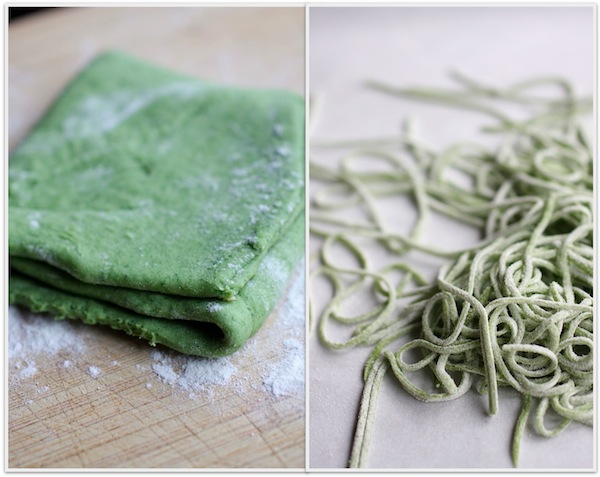
My basic recipe for the pasta dough is about 1 egg to every 3/4 cup of flour. Of course, this will vary on how big the egg is, how fresh, and what kind of flour I'm using. So it's just a starting point. I may add just a little water to the dough if I think it's too dry. If you would like a richer pasta for a special occasion, add more egg yolks to the dough. It will be wonderful.
After you make the dough, it must rest a little. Wrap the dough in a piece of floured plastic wrap and let it sit at room temperature for about 20 to 30 minutes. It will be easier to roll out.
There are different ways to roll out the dough and I prefer, of course, the easiest method - my KitchenAid pasta rollers, which you can see in action in the video. If you don't have a mixer, a hand crank pasta machine is just fine and I like this one alot and use it in my pasta making classes. But if you have a stand mixer, get the pasta rollers and cutters attachment and you will be making pasta even faster. The machine simply cranks the rollers for you, which lets you have an extra hand. If you don't have a KitchenAid mixer but would still like motorized pasta rollers, the Imperia Pasta Presto machine is fantastic and comes with many different cutters - more than the KitchenAid. This is what I would buy if I did not have my KitchenAid rollers. The most difficult way to roll out the dough is by hand with a rolling pin. If you want to do that, it is a technique that takes a lot more effort but you may find it satisfying. I prefer the machine.
Rolling out the pasta is not hard - you will get the hang of it pretty quickly. After the pasta has rested, cut off a piece about the size of the palm of your hand. Adjust the pasta rollers to #1, the widest setting, and put the pasta through. Make sure you flour the pasta dough lightly so that it doesn't stick to the rollers. After the dough comes through the rollers, fold it into thirds and pass it through the #1 slot again. Do this a couple of more times. The pasta will become very soft and velvety. Adjust the rollers to the next thinnest setting, #2, and put the pasta through. Do not fold the pasta this time. Keep passing it through the rollers, adjusting them thinner, until you reach the thickness you like. I usually stop at #5 or #6 (for ravioli, I never go beyond #5 because it will be too thin). As you pass the pasta through narrower settings, the pasta may become sticky again - keep lightly flouring it.
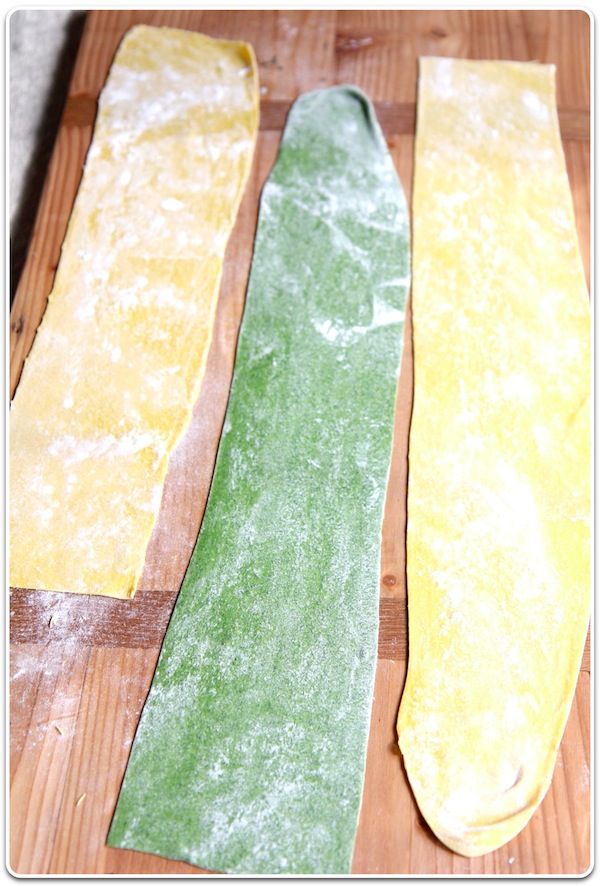
At this point, you now have fresh pasta sheets that you can make homemade lasagna with. After rolling out the pasta sheets, they must dry just a little on the counter if you want to make a cut pasta, like linguini or fettuccine. If you cut them before they have dried a little, the cutters will not cut them cleanly through. Dry them too much, however, and they will be brittle.
After your pasta has been cut, I have found that the best way to store them pasta is on a rimmed sheet pan. Toss the pasta with a little flour so it does not stick. Cover lightly with plastic wrap and place in the fridge until you cook it. I usually make the pasta in the morning but I have even made it the day before I needed it and it has done just fine in the fridge. It will stay supple and not become brittle, if you refrigerate it. Toss the pasta every once in a while with a little more flour, just to make sure it doesn't become sticky.
This recipe (1 egg + 3/4 cup flour) produces about 5 to 6 ounces of fresh pasta. It is easily doubled, tripled, etc.
To cook the pasta, boil it for only about two minutes in a large pot of salted water.
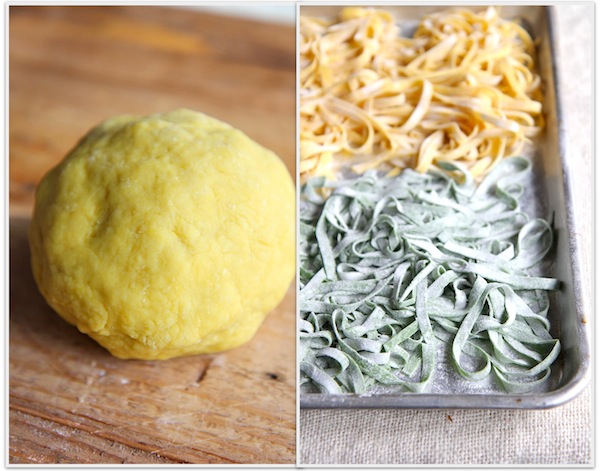
Never wash your pasta rollers - this will ruin them. Just wipe with a paper towel. If you feel you need to wash them because there are bits of dough stuck to them, then your dough was too wet. Remember to keep your dough lightly floured and it will not stick to your rollers or cutters.
Now get out there and make some pasta!
Next pasta recipe: Straw & Hay, a dish made with plain and spinach pasta.